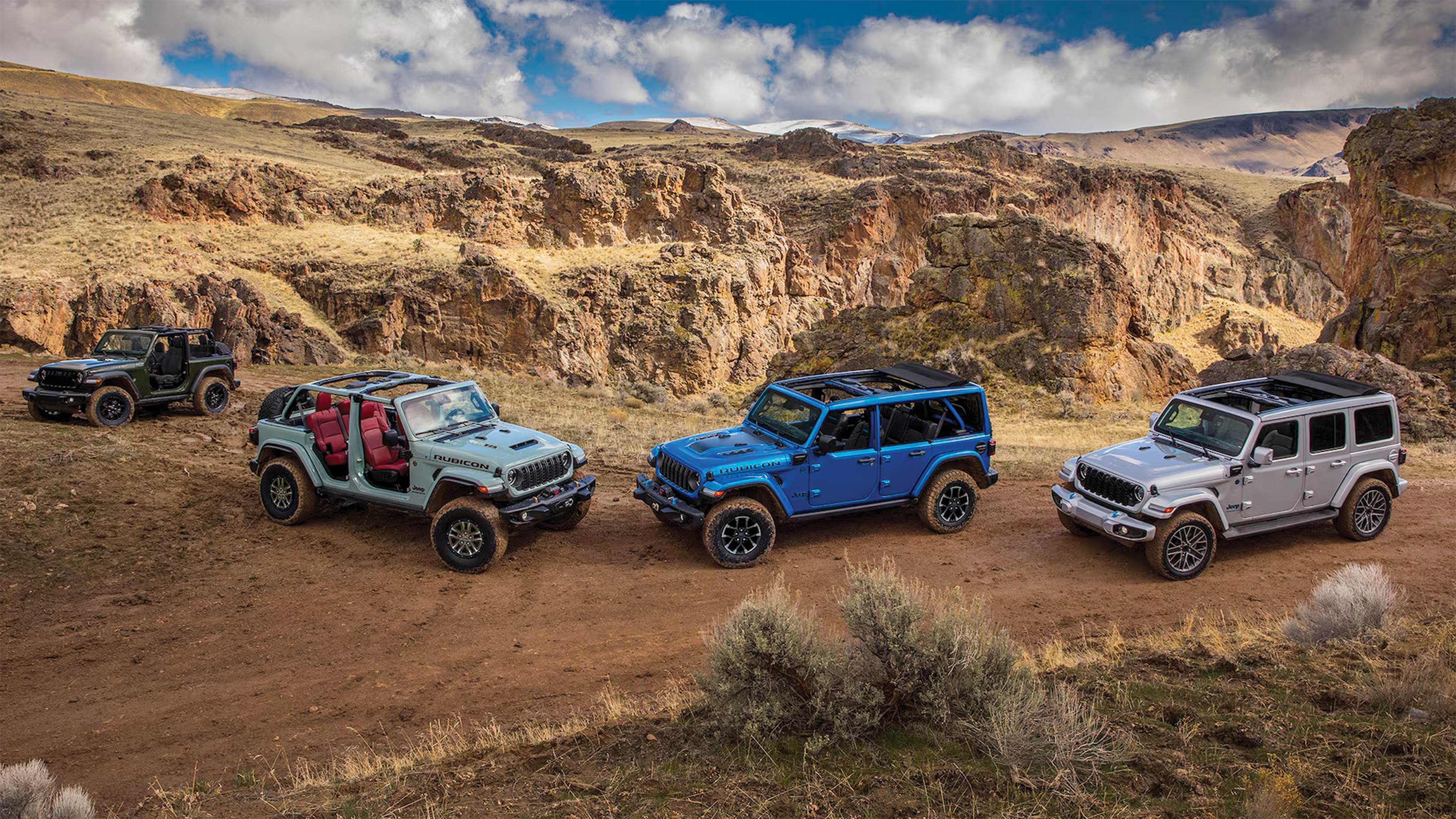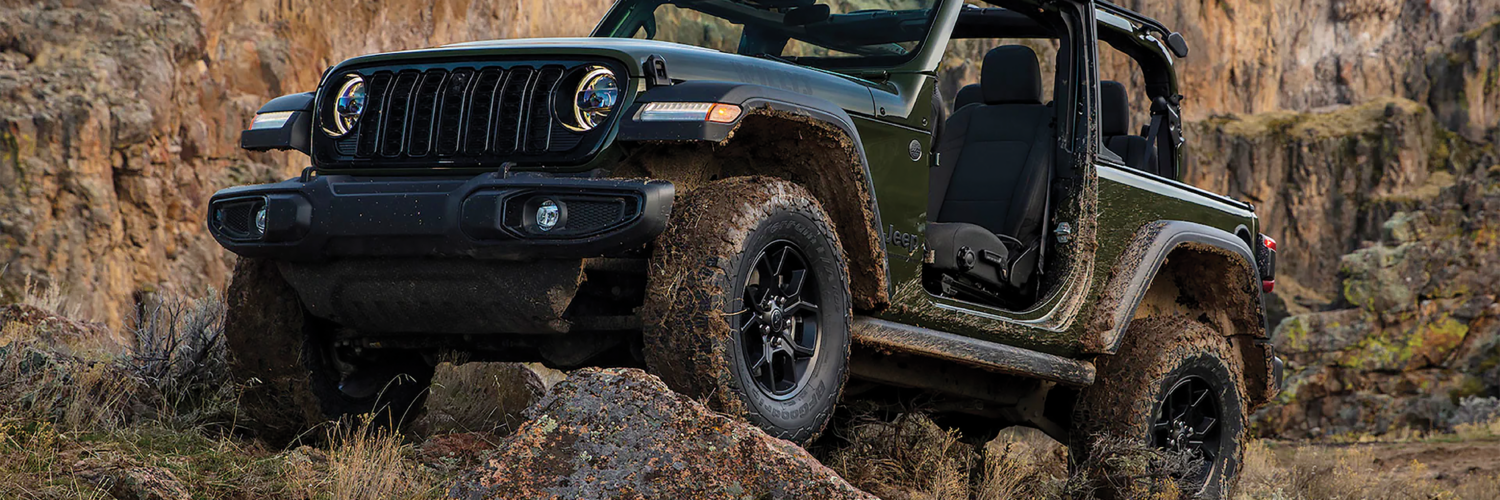ICONIC: The newcomer benefits from a mild visual and tech update with an updated grille and no fewer than 10 new wheel designs
By Ali Mphaki
All great things come in threes, right? Three meals a day, three tablets a day, three warnings before a dismissal, etc.
You also have only got three choices in life: give up, give in, or give it all you’ve got. Now the Stellantis engineers seem to have given it their all if their three facelifted models of the iconic Jeep Wrangler, namely the Wrangler Sport, Sahara and Rubicon, minus a plug-in hybrid variant offered only in overseas markets, are anything to go by.
You cant mistaken the Jeep Wrangler’s timeless design, still the same basic JL-generation Wrangler that debuted for 2019, but Jeep gives the SUV a face-lift in the form of a new seven-slat front grille that debuted on the 2023 Wrangler Rubicon 20th Anniversary edition.
The blacked-out slats are slimmer, making it easier to fit the factory-installed 8,000-pound-capacity Warn winch mounted in the steel front bumper to the hardcore Rubicon models. There are two tow hooks up front and another at the rear.
After its South African launch in 2019 with two- and four-door versions all powered by a 3.6l normally aspirated V6 petrol engine, the American SUV is now available only with four portals with power provided by a four-cylinder 2.0l petrol Turbo engine.
The new engine produces outputs of 200kW and 400Nm of torque (down 9kW and up 53Nm) and is mated to an eight-speed automatic transmission
Thanks to the use of lightweight, high-strength aluminium closures, including the doors, door hinges, hood, fender flares, windshield frame and magnesium swing gate, the weight reduction weight resulting in a claimed fuel consumption of 11.1l/100km compared with 11.7l for the outgoing V6, while the 0-100km/h time is quoted at 7.6 seconds.
Inside, a new 12.3-inch infotainment display is standard across the board and replaces the smaller 5.0- and 7.0-inch screens from last year’s Wranglers.
The new display also features Jeep’s latest infotainment software, as well as wireless Apple CarPlay and Android Auto.
Side-curtain airbags are standard in the first and second rows, 12-way power adjustable leather front seats and more than 85 safety features, including Blind-spot Monitoring, Rear Cross Path detection, adaptive cruise control further Wrangler’s refinement, Drowsy Driver Alert, and Lane Departure Warning.
The entry-level Wrangler Sport comes with standard features including adaptive cruise control, removable hardtop, LED daytime running lights, parking camera, stability control, four airbags, climate control, cloth seats and an eight-speaker audio system.
The Sahara adds features such as leather upholstery, electrically adjustable and heated front seats, navigation and leather upholstery. The range-topping Rubicon on top of that offers headlights with high-beam assist and a front off-road camera.
Sport models run on 17-inch steel wheels and Sahara models feature 18-inch alloy wheels as standard. Wrangler Rubicon is forged for off-road adventure and is shod with Mud-Terrain tyres as standard on 17-inch alloy rims.
The entry-level Wrangler Sport comes with standard features including adaptive cruise control, removable hardtop, LED daytime running lights, parking camera, stability control, four airbags, climate control, cloth seats and an eight-speaker audio system.
The Sahara adds features such as leather upholstery, electrically adjustable and heated front seats, navigation and leather upholstery.
The range-topping Rubicon on top of that offers headlights with high-beam assist and a front off-road camera.
Pricing and aftersales
The new Jeep Wrangler is covered by a 5 years/100,000km warranty and service plan including roadside assistance.
Jeep Wrangler Unlimited 2.0T Sport
R 1 199 900.00 (Recommended retail)
Jeep Wrangler Unlimited 2.0T Sahara
R 1 249 900.00 (Recommended retail)
Jeep Wrangler Unlimited 2.0T Rubicon
R 1 299 900.00 (Recommended retail)

Motoring: Briefs
NEW BMW X3
The all-new BMW X3 is now on sale in Mzansi, marking a new era for the midsize sports activity vehicle (SAV), with a choice of diesel, petrol and plug-in hybrid power as well as a more luxuriously appointed and high-tech cabin. Like the outgoing X3, which took over from the 3 Series as the company’s export hero in 2018, the next-generation X3 is built right here in South Africa, with around 96% of production set to be exported to overseas markets around the world. This follows a R4.6-billion investment in the Rosslyn-based assembly plant near Pretoria. The headline grabber is the new X3 30e xDrive plug-in hybrid (PHEV) variant, which pairs a 2.0-litre turbopetrol engine to an electric motor for system outputs of 220kW and 450Nm. BMW claims it’ll cover up to 90km on electric power alone.
JAGUAR TYPE-ZERO-ZERO
After weeks of controversy surrounding its rebranding, new direction and new logos, Jaguar will be hoping that the reveal of the Type 00 will shift the focus back on to its plans to transition to an all-electric luxury car manufacturer.
The Jaguar Type 00 is a precursor to a four-door GT car due to be revealed next summer ahead of first deliveries in late 2026, and the name, pronounced “type-zero-zero” combines Jaguar’s historic use of the word “type” with 00 to signify both the resetting of the brand and its zero-emission future. “Type 00 is the first lines ever drawn for new Jaguar – its origin story,” said managing director Rawdon Glover, describing the dramatically styled car that features a bluff front end, long bonnet, sweeping roofline and coupé fastback profile with huge rear arches, as well as the brand’s new multiple-line strikethrough design element on the front, rear, bonnet, roof and dashboard.
FORD REVIVES ORIGINAL ESCORT
FORD’s discontinued Escort MK1 will be revived in a matter of weeks with “all-new specs” – taking inspiration from an iconic racing machine. Set to be revealed on December 12, the revamped classic will come complete with a brand-new design for its daytime running lights. It will also have features from the original saloon – even down to its vehicle identification numbers which will be accurate to the period when the original car was produced – between 1967 and 1975. The car will be produced by Boreham Motorworks.
PORSCHE PROMISES
The market is not in the best of shape, but Porsche is continuing to bet on electric cars. After the Taycan and the very fresh Macan, the brand is preparing the debut of the replacements for the Boxster and Cayman, which will be exclusively battery-electric with the new generation. A major change for two models born with the sole aim of enhancing driving pleasure. In this respect, the engineers at Zuffenhausen are keen to reassure fans of the brand: these will be genuine sports cars, with a racing DNA, exploiting the experience gained in Formula E.
Admittedly, the target of 80% electric sales by 2030 has been revised downwards, but this does not mean that the commitment to the transition has been cancelled. Especially since, for Porsche, marketing a car that does not fully meet customer expectations can be very risky.
BUCKLE UP!
Volvo Cars, the inventor of the three-point safety seatbelt, is imploring drivers and passengers to buckle up this festive season. The country’s biggest seller of electric cars recently undertook a study to identify South African motorist behaviours and attitudes towards wearing the safety seatbelt.
The Volvo Car South Africa study found that 52% of 18-24 year-olds say they ‘sometimes or never wear a seatbelt’ and are the least aware of the legal requirement to wear one. This age group also had the highest confidence scores in their driving skills and ability. “More young drivers are on the road as they choose to use private transport, largely driven by accessible financing options and evolving consumer preferences. It’s imperative that we educate these young adults on the benefits of wearing a seatbelt,” said Felipe Yagi, Head of Marketing & Communications at Volvo Car South Africa.






